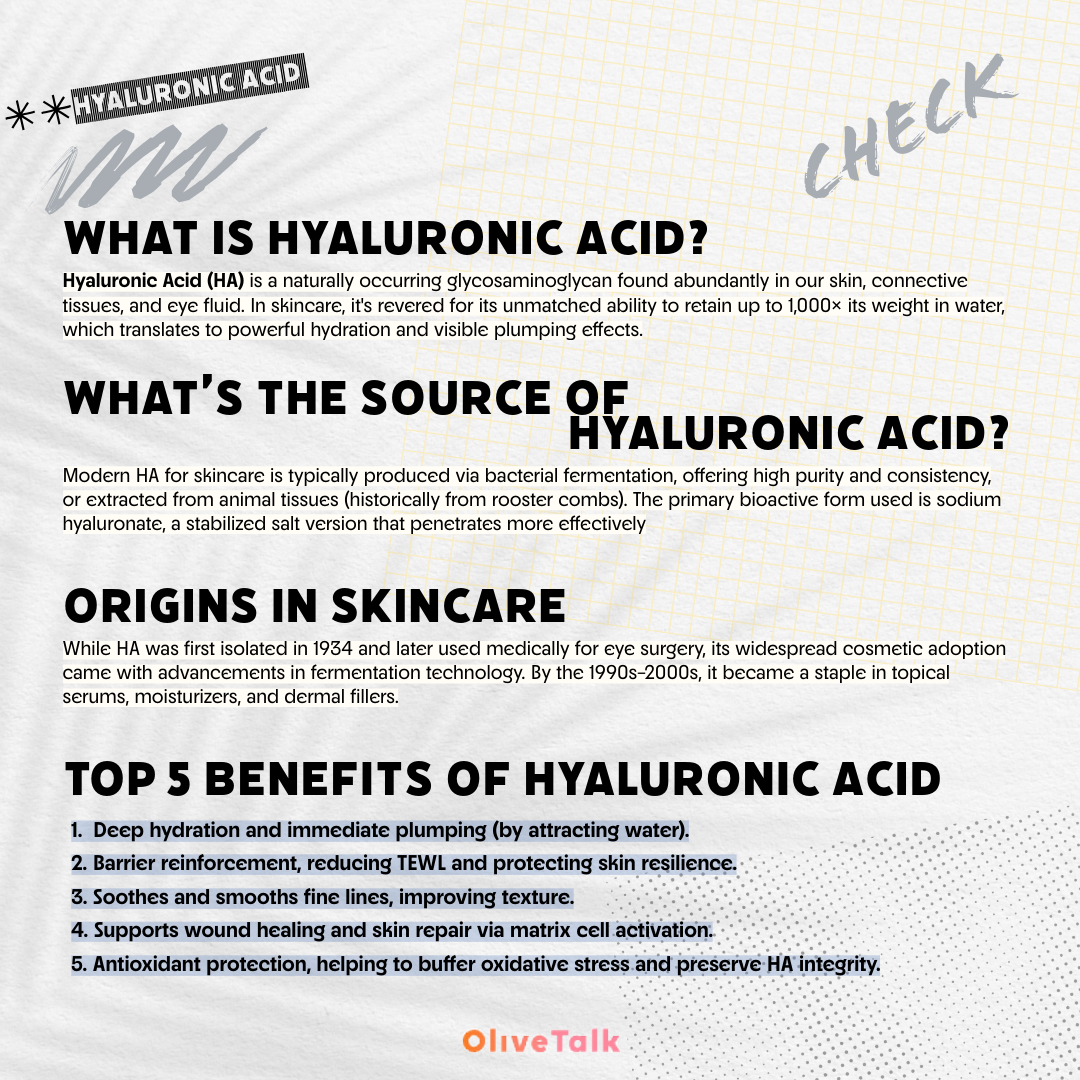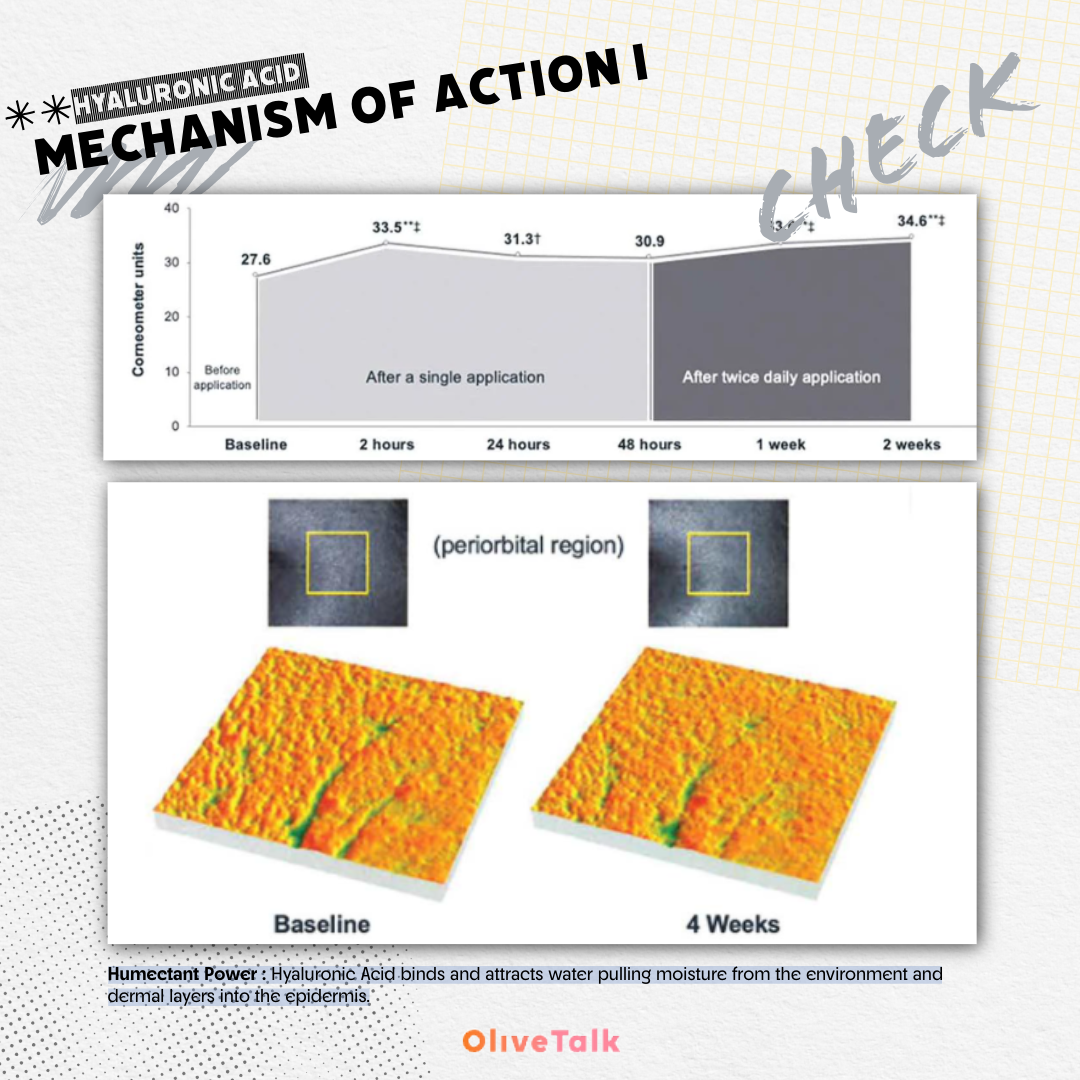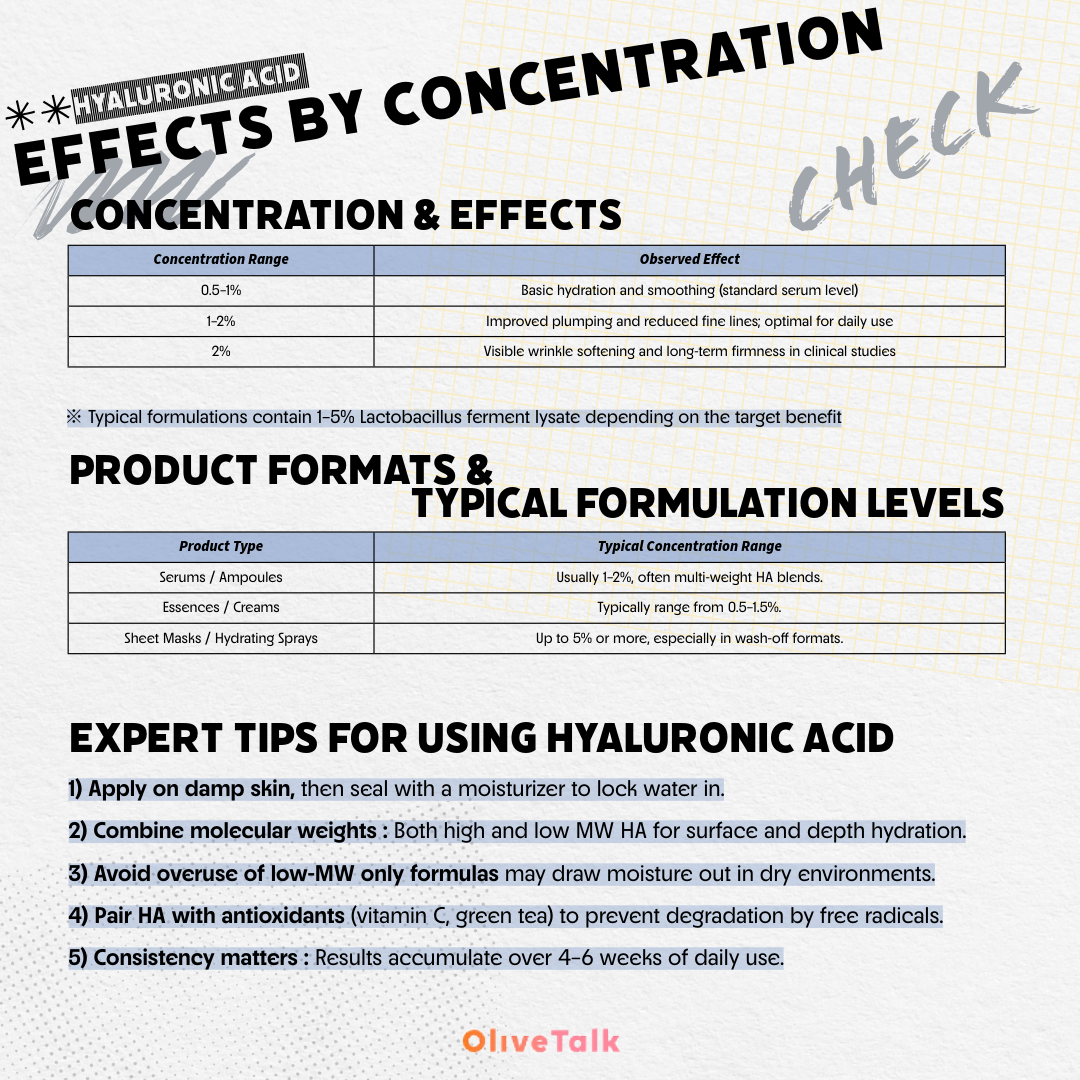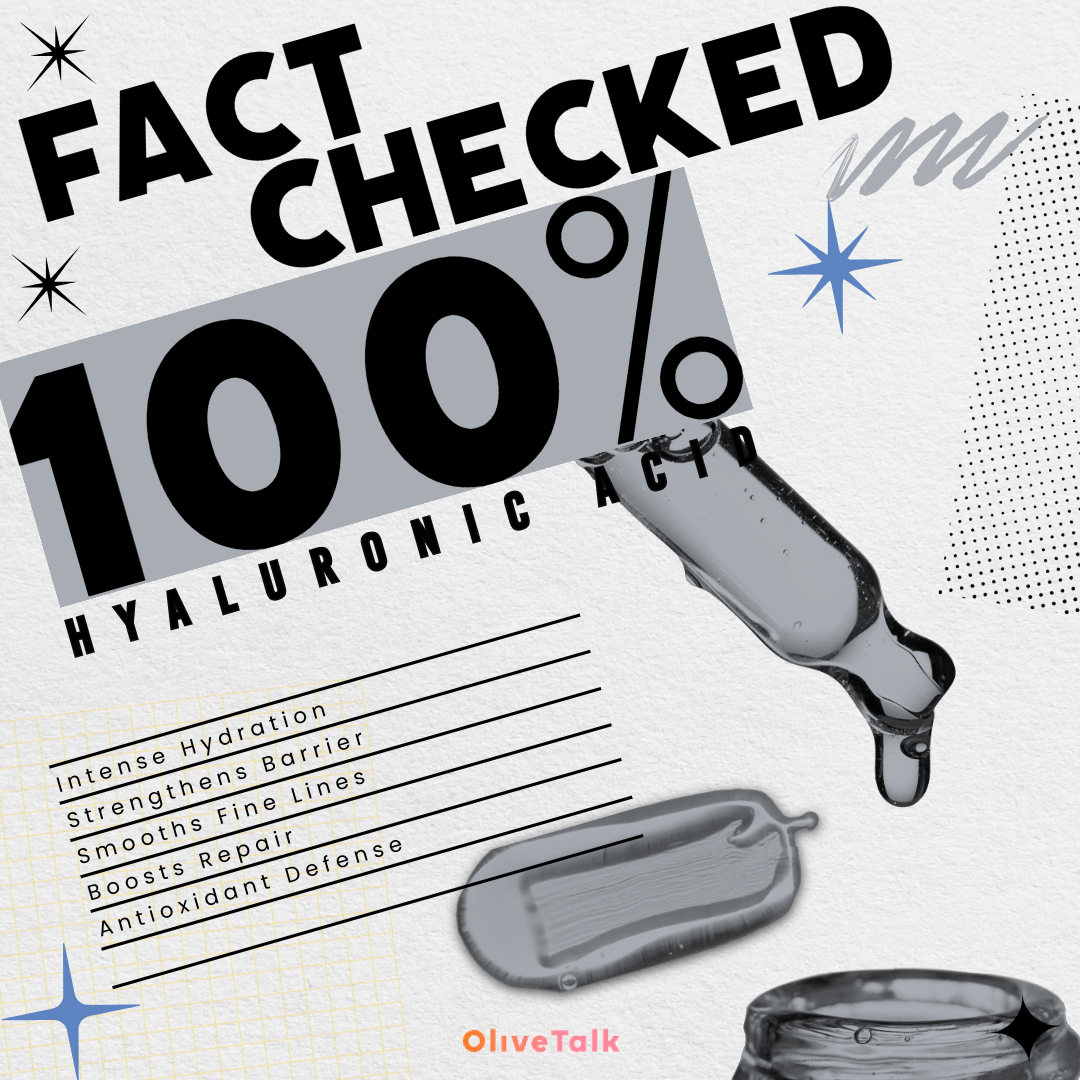

🌿 What Is Hyaluronic Acid?
Hyaluronic Acid (HA) is a naturally occurring glycosaminoglycan found abundantly in our skin, connective tissues, and eye fluid. In skincare, it's revered for its unmatched ability to retain up to 1,000× its weight in water, which translates to powerful hydration and visible plumping effects

What’s the Source of HA?
Modern HA for skincare is typically produced via bacterial fermentation, offering high purity and consistency, or extracted from animal tissues (historically from rooster combs). The primary bioactive form used is sodium hyaluronate, a stabilized salt version that penetrates more effectively
Expert Tips for Using HA
- Apply on damp skin, then seal with a moisturizer to lock water in.
- Combine molecular weights: Both high and low MW HA for surface and depth hydration.
- Avoid overuse of low-MW only formulas—may draw moisture out in dry environments.
- Pair HA with antioxidants (vitamin C, green tea) to prevent degradation by free radicals.
- Consistency matters: Results accumulate over 4–6 weeks of daily use.
🏺 Origins in Skincare
While HA was first isolated in 1934 and later used medically for eye surgery, its widespread cosmetic adoption came with advancements in fermentation technology. By the 1990s–2000s, it became a staple in topical serums, moisturizers, and dermal fillers
Top 5 Benefits of Hyaluronic Acid (Summary)
1) Deep hydration and immediate plumping (by attracting water).
2) Barrier reinforcement, reducing TEWL and protecting skin resilience.
3) Soothes and smooths fine lines, improving texture.
4) Supports wound healing and skin repair via matrix cell activation.
5) Antioxidant protection, helping to buffer oxidative stress and preserve HA integrity.

🔬 Mechanism of Action I
Humectant Power: HA binds and attracts water—pulling moisture from the environment and dermal layers into the epidermis

🔬 Mechanism of Action II
Depth Layers
High-molecular HA forms a moisture-trapping film on the surface.
Low-molecular HA penetrates deeper into the epidermis for structural hydration
Stimulates Hydration-Related Biology: By influencing hyaluronan synthase and skin cells, HA supports cell proliferation and structural integrity

Effect by Concentration
(Concentration / Observed Benefits)
- 0.5–1% / Basic hydration and smoothing (standard serum level)
- 1–2% / Improved plumping and reduced fine lines; optimal for daily use
- 2% / Visible wrinkle softening and long-term firmness in clinical studies
Common Formulations & Typical Usage Levels
- Serums / Ampoules: Usually 1–2%, often multi-weight HA blends.
- Essences / Creams: Typically range from 0.5–1.5%.
- Sheet Masks / Hydrating Sprays: Up to 5% or more, especially in wash-off formats.

<Top 5 Skincare Products Infused with Hyaluronic Acid Extract>
1. Missha Time Revolution Night Repair Ampoule
Content : ~2–3%
Country : KR
2. Skin1004 Madagascar Hyalu-Cica Serum
Content : no information
Country : KR
3. Pyunkang Yul Hyaluronic Acid Aqua Gel Cream
Content : ~2%
Country : KR
4. CosRX Hydrium Triple Hyaluronic Moisture Ampoule
Content : ~3%
Country : KR
5. Dr. Jart+ Water Fuse Hydro Sleep Mask
Content : ~1–2%
Country : KR
Clinical Efficacy Highlights
- A study by Draelos (2021): Topical HA serum improved skin hydration by ~55% and plumping effect within 6 weeks, without irritation
- Clinical trial of multi-weight HA plus antioxidant cosmetics found improvements in moisture, lines, texture from Week 2, with more dramatic effects by Week 4–8
- Single application studies demonstrate immediate 24-hour hydration + barrier function improvement using HA-based formulas
Then vs. Now: Evolution of HA
- Then (1950s–70s): HA limited to injections and pharmaceuticals.
- Now: Multi-chain molecular weight blends, stabilized sodium hyaluronate, nano-HA for penetration, plus synergistic antioxidant combinations—formulated for daily skincare routines.

📚 References
Draelos ZD et al., Dermatol Ther (2021) — Topical HA serum efficacyPMC+1ResearchGate+1
Bravo B. et al., J Cosmet Dermatol (2022) — Rejuvenation via HA cosmeceuticalsPMC
Lain EL et al., J CAD Online (2024) — Multi-weight HA + antioxidant study JCAD+1JCAD+1
Milani M. et al., Clin Cosmet Invest Dermatol (2017) — 24-hour barrier function effects Dove Medical Press
Wikipedia: Hyaluronic acid biology and synthesis
INCI decoding discussions (1% HA typical) Reddit+1humblebeeandme.com+1
 77Comments
77Comments-
 FemaleSensitive21 days agoMy fav ingredient!! The most basic and effective one🥰
FemaleSensitive21 days agoMy fav ingredient!! The most basic and effective one🥰 -
 FemaleOily21 days agoSkin 1004 serum is my holy graillllll
FemaleOily21 days agoSkin 1004 serum is my holy graillllll FemaleNormal21 days agoLove this brand too but i thought they were only focusing on centella but guess i was wrong 😅
FemaleNormal21 days agoLove this brand too but i thought they were only focusing on centella but guess i was wrong 😅 -
 FemaleCombination21 days agoLayering HA under my occlusion moisturizer wad the best skincare for me during the winter
FemaleCombination21 days agoLayering HA under my occlusion moisturizer wad the best skincare for me during the winter -
 FemaleSensitive21 days agoHA works better for me in gel textures than in creames ✨️
FemaleSensitive21 days agoHA works better for me in gel textures than in creames ✨️ FemaleOily21 days agoFor me too!! But never know why 😂😂
FemaleOily21 days agoFor me too!! But never know why 😂😂 -
 FemaleSensitive21 days agoMy skin barrier literally healed after 2 weeks of daily HA and ceramide cream combo
FemaleSensitive21 days agoMy skin barrier literally healed after 2 weeks of daily HA and ceramide cream combo FemaleSensitive21 days agoWhich ceramide product did u use?? I'm searching for a nice one
FemaleSensitive21 days agoWhich ceramide product did u use?? I'm searching for a nice one FemaleSensitive21 days ago@Female/Sensitive I use illiyoon ceramic lotion!! Very mild
FemaleSensitive21 days ago@Female/Sensitive I use illiyoon ceramic lotion!! Very mild FemaleSensitive21 days ago@Female/Sensitive Oh I've heard of that before!! Ty for the rec 😊
FemaleSensitive21 days ago@Female/Sensitive Oh I've heard of that before!! Ty for the rec 😊 -
 FemaleOily21 days agoDo u think nano HA is worth the hype or just marketing fluff??
FemaleOily21 days agoDo u think nano HA is worth the hype or just marketing fluff?? -
 FemaleNormal21 days ago2% HA was just perfect for me. More than that feels heavy for my combo skin
FemaleNormal21 days ago2% HA was just perfect for me. More than that feels heavy for my combo skin -
 FemaleCombination21 days agoHaving to use HA on damp skin is so shocking 🤯 never even thought of it
FemaleCombination21 days agoHaving to use HA on damp skin is so shocking 🤯 never even thought of it FemaleSensitive21 days agoU rly shoulddddddd worked at least twice better for me
FemaleSensitive21 days agoU rly shoulddddddd worked at least twice better for me -
 FemaleOily21 days agoHA sheet masks r must have for a long flight 😌😌
FemaleOily21 days agoHA sheet masks r must have for a long flight 😌😌 -
 FemaleSensitive21 days agoMost basic but the most solid
FemaleSensitive21 days agoMost basic but the most solid FemaleSensitive21 days agoFr ppl should stop hyping fancy looking marketing ingredients bit focus more on the basic
FemaleSensitive21 days agoFr ppl should stop hyping fancy looking marketing ingredients bit focus more on the basic -
 FemaleOily21 days agoHas anyone tried the cosrx one?? The conc seems quite high
FemaleOily21 days agoHas anyone tried the cosrx one?? The conc seems quite high FemaleNormal21 days agoIm curious too. Wonder if it would be sticky or not
FemaleNormal21 days agoIm curious too. Wonder if it would be sticky or not -
 FemaleCombination21 days agoI knew that my skin love HA but didn't know about its mechanism! Interesting
FemaleCombination21 days agoI knew that my skin love HA but didn't know about its mechanism! Interesting -
 FemaleSensitive21 days agoThx for a lovely breakdown 💕💕
FemaleSensitive21 days agoThx for a lovely breakdown 💕💕 -
 FemaleOily21 days agoDidn't know that it was used in eye surgery 😲😲
FemaleOily21 days agoDidn't know that it was used in eye surgery 😲😲 -
 FemaleSensitive21 days agoAny recs for HA serums that don't pill under sunscreen?
FemaleSensitive21 days agoAny recs for HA serums that don't pill under sunscreen? -
 FemaleSensitive21 days agoLove its combo with niacinamide😘
FemaleSensitive21 days agoLove its combo with niacinamide😘 -
 FemaleOily21 days agoCalling HA a moisture magnet is so accurate loll
FemaleOily21 days agoCalling HA a moisture magnet is so accurate loll -
 FemaleNormal21 days agoNothing beats it for fixing inner dryness
FemaleNormal21 days agoNothing beats it for fixing inner dryness FemaleCombination21 days agoFr the best when yr skin surface is oily but inner layer feels dehydrated
FemaleCombination21 days agoFr the best when yr skin surface is oily but inner layer feels dehydrated -
 FemaleSensitive21 days agoLove how the science explains why it keeps skin hydrated
FemaleSensitive21 days agoLove how the science explains why it keeps skin hydrated -
 FemaleOily21 days agoEven my oily skin craves HA even during the summer
FemaleOily21 days agoEven my oily skin craves HA even during the summer -
 FemaleSensitive21 days agoAnyone who tried the pyungkangyul gel cream??
FemaleSensitive21 days agoAnyone who tried the pyungkangyul gel cream?? -
 FemaleSensitive21 days agoThis is such a clear breakdown! Thanks for making ha feel so approachable
FemaleSensitive21 days agoThis is such a clear breakdown! Thanks for making ha feel so approachable -
 FemaleNormal21 days agoI only ever thought of HA as a hydrating imgredient, never knew it helped with barrier repair too
FemaleNormal21 days agoI only ever thought of HA as a hydrating imgredient, never knew it helped with barrier repair too -
 FemaleOily21 days agoso using multi weight HA is really the secret fir that glass skin look? intriguing
FemaleOily21 days agoso using multi weight HA is really the secret fir that glass skin look? intriguing -
 FemaleCombination21 days agoCan anyone explain the difference between high mw and low mw in simpler terms?
FemaleCombination21 days agoCan anyone explain the difference between high mw and low mw in simpler terms? -
 FemaleSensitive21 days agoMy skincare table includes a pure ha serum, I'm now questioning I'd I need more than just single weight
FemaleSensitive21 days agoMy skincare table includes a pure ha serum, I'm now questioning I'd I need more than just single weight -
 FemaleNormal21 days agoTried the pungkangyul gel cream! They hydrate well, but I didn't know it had ~2% HA
FemaleNormal21 days agoTried the pungkangyul gel cream! They hydrate well, but I didn't know it had ~2% HA -
 FemaleOily21 days agoSo is it best to stick to 1-2% HA for daily use? anything higher seems overkill
FemaleOily21 days agoSo is it best to stick to 1-2% HA for daily use? anything higher seems overkill FemaleCombination21 days agoI tried a 5% hyaluronic toner once and my skin got a little irritated. Lesson learned
FemaleCombination21 days agoI tried a 5% hyaluronic toner once and my skin got a little irritated. Lesson learned FemaleNormal21 days ago@Female/Combination Thanks good reminder to patch test before going high
FemaleNormal21 days ago@Female/Combination Thanks good reminder to patch test before going high -
 FemaleCombination21 days agoHonest opinion HA is too basic. Give me niacinamide or peptides any day
FemaleCombination21 days agoHonest opinion HA is too basic. Give me niacinamide or peptides any day -
 FemaleOily21 days agothis post made me want to review my own HA usage. I think I'm overusing the low-MW forms
FemaleOily21 days agothis post made me want to review my own HA usage. I think I'm overusing the low-MW forms -
 FemaleNormal21 days agoCan't wait to mix HA serum into my am routine instead of nighttime only
FemaleNormal21 days agoCan't wait to mix HA serum into my am routine instead of nighttime only -
 FemaleSensitive21 days agoI've had zero irritation with ha plus vitamin C Works like a charm
FemaleSensitive21 days agoI've had zero irritation with ha plus vitamin C Works like a charm -
 FemaleSensitive21 days agoAnyone else use the Dr.jart mask daily? I'm debating if that's overkill
FemaleSensitive21 days agoAnyone else use the Dr.jart mask daily? I'm debating if that's overkill -
 FemaleNormal20 days agoShort and sweet : HA is hydration hero
FemaleNormal20 days agoShort and sweet : HA is hydration hero -
 FemaleOily20 days agolove how this post breaks down "why" HA works not just marketing fluff
FemaleOily20 days agolove how this post breaks down "why" HA works not just marketing fluff -
 FemaleCombination20 days agoWhat's better for dry area, high MW it low MW HA?
FemaleCombination20 days agoWhat's better for dry area, high MW it low MW HA? FemaleOily20 days agoHigh MW holds water on the surface, while low MW get deeper a combo is best
FemaleOily20 days agoHigh MW holds water on the surface, while low MW get deeper a combo is best FemaleNormal20 days ago@Female/Oily I do exactly that. Layer a lightweight HA serum followed by a thicker HA drop if needed
FemaleNormal20 days ago@Female/Oily I do exactly that. Layer a lightweight HA serum followed by a thicker HA drop if needed FemaleCombination20 days ago@Female/Oily Great advice adding that combo to my routine tonight
FemaleCombination20 days ago@Female/Oily Great advice adding that combo to my routine tonight -
 FemaleSensitive20 days agoI read Ha can draw moisture out in dry climates if not paired with moisturizer, anyone experience that?
FemaleSensitive20 days agoI read Ha can draw moisture out in dry climates if not paired with moisturizer, anyone experience that? FemaleNormal20 days agoTotally. It happened to me when I flew ro Denver. My skin felt tight later afternoon unless I followed up with a cream
FemaleNormal20 days agoTotally. It happened to me when I flew ro Denver. My skin felt tight later afternoon unless I followed up with a cream FemaleSensitive20 days agoSo layering is non negotiable. Got it
FemaleSensitive20 days agoSo layering is non negotiable. Got it -
 FemaleOily20 days agowhy didn't my dermatologist ever explain HA like this? instead I got vague "drink water" advice lol
FemaleOily20 days agowhy didn't my dermatologist ever explain HA like this? instead I got vague "drink water" advice lol -
 FemaleCombination20 days agoMy skin feels plump since starting a multi weight HA serum. Can confirm this!
FemaleCombination20 days agoMy skin feels plump since starting a multi weight HA serum. Can confirm this! -
 FemaleSensitive20 days agoQuick question 👋👋 does ha break you out? Mine is acne prone
FemaleSensitive20 days agoQuick question 👋👋 does ha break you out? Mine is acne prone -
 FemaleNormal20 days agoSaved! Bookmarking that so I can stop buying random HA formulas
FemaleNormal20 days agoSaved! Bookmarking that so I can stop buying random HA formulas -
 FemaleOily20 days agoI actually use ha only after working out! that post exercise hydration is real lol
FemaleOily20 days agoI actually use ha only after working out! that post exercise hydration is real lol -
 FemaleCombination20 days agoUsing cosrx ampoule and it feels silky. Didn't know if was 3% HA!
FemaleCombination20 days agoUsing cosrx ampoule and it feels silky. Didn't know if was 3% HA! -
 FemaleNormal15 days agoMissha ampoule is my holy grail. The plumping is real
FemaleNormal15 days agoMissha ampoule is my holy grail. The plumping is real -
 FemaleNormal15 days agoCouldn't feel any effect using HA solely
FemaleNormal15 days agoCouldn't feel any effect using HA solely FemaleCombination15 days agoSame 😭😭
FemaleCombination15 days agoSame 😭😭 FemaleOily15 days agoMe too. Ofc it was hydrating but long term difference? No
FemaleOily15 days agoMe too. Ofc it was hydrating but long term difference? No -
 FemaleNormal15 days agoHA sheet masks before makeup makes the flawless base
FemaleNormal15 days agoHA sheet masks before makeup makes the flawless base -
 FemaleNormal15 days agoGirls u shouldn't use HA moisturizer on its own. Gotta lock it in
FemaleNormal15 days agoGirls u shouldn't use HA moisturizer on its own. Gotta lock it in FemaleCombination15 days agoSo true. It does need sealing.. otherwise my skin feels tight
FemaleCombination15 days agoSo true. It does need sealing.. otherwise my skin feels tight FemaleOily15 days ago@Female/Combination Using it after toner and before moisturizer was the best for me
FemaleOily15 days ago@Female/Combination Using it after toner and before moisturizer was the best for me -
 FemaleNormal15 days agoAnyone tried mixing HA serum with glycerin?? Heard it amps up hydration
FemaleNormal15 days agoAnyone tried mixing HA serum with glycerin?? Heard it amps up hydration -
 FemaleNormal15 days agoLove the skin1004 one 😘
FemaleNormal15 days agoLove the skin1004 one 😘 -
 FemaleCombination9 days agoCombining molecular weights is such a helpful tip!! Never even thought of it
FemaleCombination9 days agoCombining molecular weights is such a helpful tip!! Never even thought of it -
 FemaleSensitive9 days agoAll girlies need HA no matter what skin type
FemaleSensitive9 days agoAll girlies need HA no matter what skin type FemaleDry9 days agoFr hydration is the most basic thing u need for every aspect of yr skin
FemaleDry9 days agoFr hydration is the most basic thing u need for every aspect of yr skin -
 FemaleSensitive9 days agoWill it be more effective when it has higher concentration than 2%?
FemaleSensitive9 days agoWill it be more effective when it has higher concentration than 2%? FemaleNormal9 days agoIm also curious. Can HA also irritate skin if its conc gets too high?
FemaleNormal9 days agoIm also curious. Can HA also irritate skin if its conc gets too high? -
 FemaleCombination9 days agoGuys torriden is also real good at making HA products
FemaleCombination9 days agoGuys torriden is also real good at making HA products -
 FemaleSensitive9 days agoLove that u also show mechanism!!
FemaleSensitive9 days agoLove that u also show mechanism!! -
 FemaleDry9 days agoPersonally think HA works better in low MW
FemaleDry9 days agoPersonally think HA works better in low MW